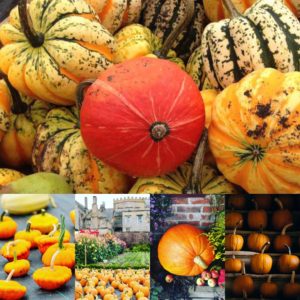
Here’s my pick of the best winter squash – a group of pumpkins, gourds and hybrids that have skins that ripen into hard rinds meaning they keep for winter (Summer squash gherkins and cucumbers don’t).
You might have read that pumpkins are good crops to grow on new plots as the giant umbrella-like leaves supress weeds. Sadly I’ve never found this to be true –in-fact nettles and couch grass seem to thrive in their cool shade and worse hole-up amongst the stems safe out of weeding’s way. A mulch of cardboard boxes before planting works better. Although relatively thin and soft when soggy it makes a surprisingly good weed-barrier.
HOW TO GROW
I used to sow all of my squash in pots in the greenhouse, hardening them off once they’d sprouted before planting them out after the frosts. It’s still a good method for more tender types like cucumbers and bottle gourds or for growing potential prize-winning pumpkins but for the rest I sow straight into the soil.
Winter squash are often mollycoddled when actually the seeds are pretty irrepressible. The spent fruit of a pumpkin for example if left to rot on the compost heap or inside a wormery will often survive and be only too happy to come up amongst the carrots when the compost is spread.
I sow in May (early May if it’s warm and late if it’s not) first punching through the mulch and card to make a shallow slit in the soil below and then drop two seeds (one for luck) into the gap. I water them in (about half a litre) and then brush the green-compost over the top to make sure they’re covered.
Spaced every 1.2m (4ft) across the area the pumpkins are up within a fortnight and quickly spread to form a mat of green leaves that covers the whole area. Last year I sowed a second batch of seeds in late June (and kept my fingers crossed that it’d be an Indian summer) when it was dry so used an overhead sprinkler to give them a boost but apart from that didn’t have to bother.
One thing about using cardboard mulch is that once the crops are gathered in and the tangle of stems cleared to the compost there are always lengths of packing tape to rake up and bin. This is a small price to pay as the soil freshly worked by worms (worms love eating damp cardboard) is left in really good condition – perfect for a September sowing of phacelia or a ryegrass green manure.
My crop of pumpkins and gourds looked and went down a treat – and here’s hoping that this autumn l have even more!
SQUASH TYPES
Another difference between summer and winter squash is that the summer types are picked regularly to encourage more fruit. That said many including courgettes and the flying saucer-shaped patty pans can be left to swell and harden although they lose some of their delicacy.
Acorn squash so called as they look like super-sized acorns inside their cups. A favourite in the USA. Mostly green with moist sweet flesh
Cheese pumpkins – pale pleated skins give then the look of cheese wheels with firm good-for-roasting flesh. My favourite is the similar and red ‘Rouge vif detempes’
Butternuts – their big advantage is that they don’t have large stringy cavities so are easy to prepare. They do well in raised beds where drainage is guaranteed. Good nutty taste but I prefer the less ubiquitous Banana squash
Spaghetti – my favourite squash which are less about taste and all about the texture. When cooked the flesh turns into noddle-like strings that when roasted soaks up the flavour of bacon and tomatoes
Buttercup squash – small fruits with thick walls and lots of creamy yellow flesh. Similar in taste to the knobble-topped Turks turbans. Very mild floury flavour that soaks up other spices
Sweet dumpling squash – mini-me pumpkins growing just 12cm across. Sweet but dry flesh
Delicatta – looks a little like an ornamental gourds with striped and speckled skins. They don’t keep that well as the skins are thin but they’re as tasty as sweet potatoes especially with lots of butter
Hubbard – thick skins, and hefty size plus the fact that they sweeten over time make hubbards the best for storing. Yellow flesh lovely roasted
Kabocha – nutty flavour that holds its shape when cooked so good for adding body to veggie curries. From Japan and mostly green with a sweet potato taste
Serpentine squash – I like these the large and long snake like gourds. Tromba di albeng (seedsofitaly.co.uk) is a particular favourite. Sliced and fried or oiled and grilled on the bbq they taste like a pattypan
Pattypan –doesn’t scramble on long vines like the above but has really beautiful flying-saucer-shaped fruit with a nutty flavour
The Inedibles
Ornamental gourds – mixtures of bottle, pear and swan-necked fruit in freckled whites and greens. Not edible but great autumnal decorations
Squirting cucumbers – a real favourite with my kids – touch the ripened fruit and the pods propel themselves across the garden on a jet of seeds and water. Not for the pot or the faint-hearted

